One grand mission
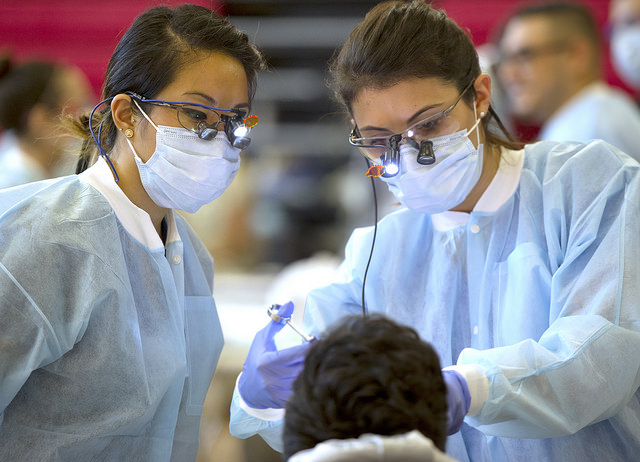
During Operation Lone Star, every minute counts.
It’s 3 a.m. on Aug. 4 in Mission, Texas, three miles from the Texas-Mexico border. The air is still. The heat from the previous afternoon lingers. Like most August days in South Texas, this one will be a scorcher. This, however, is no ordinary day. While most of Mission sleeps, there’s already a buzz of activity on the Palmview High School campus.
A Texas State Guard member emerges from the high school’s glass-clad foyer into the night carrying a stack of several hundred sequentially numbered slips of paper. He is greeted with a sleepy acknowledgment from the folks at the front of the line. There are hundreds of adults and children behind them. Many began assembling there 12 hours earlier to guarantee they received a number. The piece of paper is worth the wait; it promises access to medical care that day.
It is the first day of Operation Lone Star – a full-scale simulated emergency response exercise accompanied by free medical and dental services for local residents, with no identification or documentation requested. Palmview High School is just one of five locations in four counties serving as command centers for the weeklong activities.
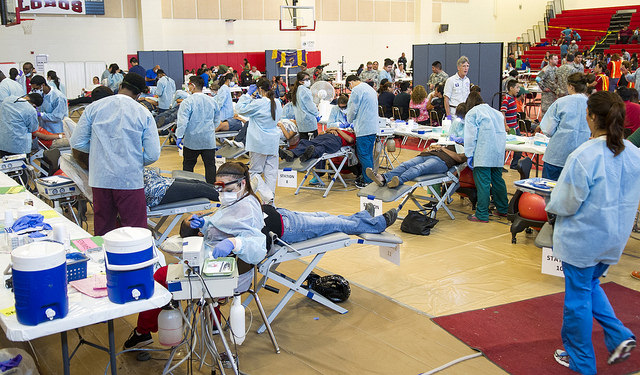
A vast collaborative effort of Texas county and state public health professionals, the operation comprises Texas Military Forces, U.S. military personnel, the Remote Area Medical Volunteer Corps and hundreds of civilian volunteers. Among them are faculty and 36 dental and dental hygiene students from Texas A&M University Baylor College of Dentistry.
Serving alongside other dental professionals, medical personnel and area high school and college students, the dental and dental hygiene students’ world for the week consists of caring for their patients within the high school gymnasium. In this climate-controlled environment, their adversary is not the South Texas heat – it’s time.
6:20 a.m.
Irene arrives in the predawn darkness at the high school, where the line snakes down the sidewalk and around the building. Irene’s sister drove 40 miles to attend with her. The two discover too late they have inadvertently selected a parking area on the opposite side of the building from the back of the line. They walk through the darkness past the crowd, many of whom spent the past several hours sleeping in their cars after receiving numbers. The sisters make a mental note of a better parking area and earlier arrival time for next year. At Operation Lone Star, line placement determines everything.
7:45 a.m.
A guard member unlocks the doors, and patients clutching numbers shuffle into the entry area. In addition to dentistry, Operation Lone Star offers comprehensive medical screenings, blood pressure checks, diabetes screenings, immunizations for children, school physicals, hearing tests, nutritional counseling and vision care. While dental services are provided in the gymnasium, vision screenings and other medical services take place in various campus classrooms and offices. Each person who enters receives a uniquely coded wristband that will be scanned at each service location. This facilitates precise tracking of patients and their records throughout the day.
Nancy Treviño, assistant coordinator for public health emergency preparedness in Hidalgo County, explains the value of the free medical and dental care.
“The population here is low income; a lot of people just came from Mexico, and English is a second language,” says Treviño. “Kids are in school here, family members are surviving and working here, but they have no insurance and no money for doctor visits.”
Numbers gleaned from census bureau estimates, Texas State Data Center predictions and county health statistics illustrate these facts. With a projected population of nearly 863,000, 91 percent of which is Hispanic or Latino, and a median household income of approximately $33,000, Hidalgo County far exceeds the state average for children in poverty and the uninsured. More than one-third of the adult population here is obese, and 27 percent of residents report poor or fair health.
10:00 a.m.
Just a couple hours into the event, already 537 patients have registered for medical, dental or vision services. Chris Hall of Remote Area Medical observes the lack of severe bottlenecks on this first morning of the five-day event.
RAM, a nonprofit based in Rockford, Tenn., prepares and ships supplies and equipment and handles setup and logistics for free clinic events in underserved areas around the country. This is RAM’s third year with Operation Lone Star.
Dental care is in demand at these events, he says, citing how the 200 dental slots allotted for the day are already filled.
“It doesn’t mean the ones who got medical only because dental was full can’t come back on another day,” Hall says. “Ninety percent of patients at RAM clinics want dental or vision. These services also take the longest out of those offered. We want to be able to help the most people possible each day, so we have patients choose one. When that is finished they can go to the back of the line for the other if they want.”
In the dental screening area, A&M Baylor College of Dentistry faculty members assist patients at a brisk pace.
“Is there anything bothering you?” asks Dr. Lorenzo Prats, assistant professor of restorative sciences, as he assesses one young man’s dental needs before directing him to the treatment area. Patients such as this one are much more than numbers to this seasoned dentist.
“This is so memorable,” he says. “I saw a lot of need. They’re all important to me.”

Dr. Stephen Crane, associate professor of public health sciences, screens one patient with only 12 teeth, all worn down to the gumline, and another with tartar so severe it forms a bridge that obscures the entire back side of the teeth. He nods toward the students hovering over patients in one sweeping row of chairs on the right side of the room.
“My hat is off to these dental hygiene students,” he says. “We couldn’t see nearly as many patients if we didn’t have them here. They work harder than anybody.”
11:30 a.m.
Outside in a service drive alcove, a customized recreational vehicle known as the “vision truck” sits baking in the midday heat. Inside its air-conditioned interior – gutted to make room for machines and metal chests of drawers – volunteers are busy grinding raw materials into prescription lenses for eyeglasses.
Jeff Eastman, a RAM employee who traveled to South Texas from Tennessee headquarters, is crafting glasses with help from volunteers. Back home, Eastman is RAM’s chief business officer, but at this event he’s “just a volunteer” who says it is easy to instruct anyone how to help.
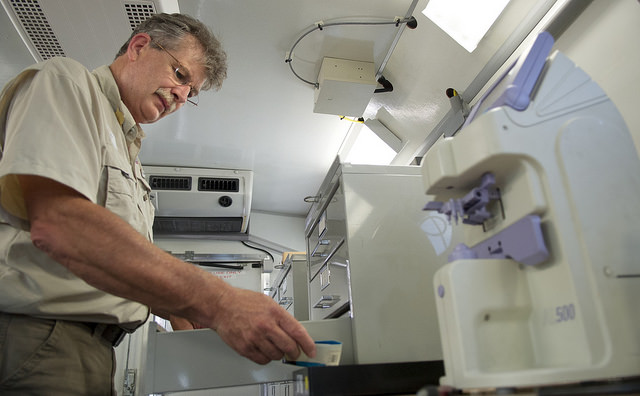
Alyssa Garza, a senior at the University of Texas-Pan American in Edinburg, Texas, aspires to become an optometrist and asked specifically to volunteer for the vision truck.
“I’m here for the experience,” she says over the whir of the grinding machine, adding that her work started around 8 a.m., and things have been so busy she lost count of the number of lenses she’s made. Final numbers show that over the course of the week, 573 individuals received prescription glasses free of charge.
12:30 p.m.
In the gym, TAMBCD students plug away at dental care, some perched on makeshift dental stools: stability balls nested within light plastic frames. Local dental assisting students offer chairside help, sterilization and translation assistance.
Military dentists, public health and private practice volunteers also provide patient care at the event. Upon leaving the dental screening area, 14-year-old Jose makes his way to a dental chair where Dr. Gustavo Gonzalez-Nieto is waiting. Gonzalez-Nieto, a member of the Texas Army National Guard and 2008 TAMBCD graduate, is in private practice in Teague, Texas, but arrived Saturday to spend the week at Operation Lone Star. He will handle Jose’s extraction.
Looking on from the side of the treatment area, Jose’s mom, Elizabeth, explains through a volunteer translator – high school senior and Junior ROTC member Monica Garcia – that she is attending Operation Lone Star with her four children. She waits for her turn to have a cavity filled. Elizabeth attended last year’s event and does not receive dental care anywhere else.
“It brings a lot of help economically,” Elizabeth says. “I took my son to another clinic, and the dentist said he needed a lot of expensive work. It was too much for me.”
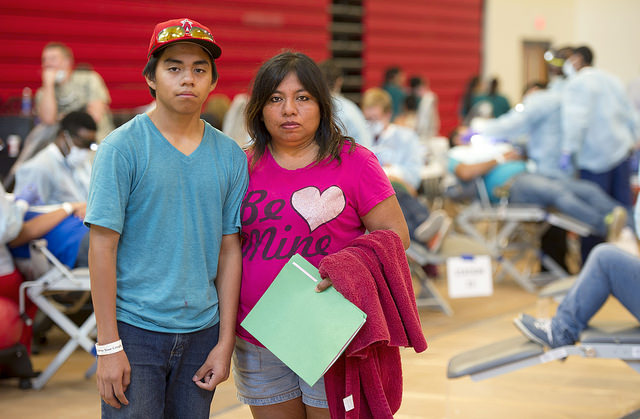
1:00 p.m.
Col. J.P. Fancher of Martindale, Texas, is the only dentist in the Texas State Guard, a volunteer organization of mission-ready forces available to supplement Texas military and civil authorities. His involvement in this group follows three decades in the Air Force; many retired military are guard members, he says.
It’s Fancher’s third year working with Remote Area Medical and A&M Baylor College of Dentistry at Operation Lone Star. RAM rolls into town and provides the setup: sterilization equipment, X-ray units, operatories, generators to run the dental equipment, and air compressors and suction. TAMBCD provides the students.
“It’s really kind of neat,” Fancher says. “We could not have done this without the Baylor cohort!
“The patients are usually very easy to work with and very appreciative. We provide what we can in 45 minutes to an hour including restorations, prophies and preventive care, not just extractions. We can’t fix all their problems, but they go away with something good.”
1:30 p.m.
Third-year dental student Jonathan Havener heads for a late lunch after completing a complicated case, his third of the morning.
“This patient had gone 30 years with half a tooth after it cracked off,” says Havener, who used composite matching her tooth color to create an esthetic restoration.
He receives chairside assistance from Aleina Solis, a dental assisting student at South Texas Vocational Technical Institute in McAllen. This last patient has more problems than a cracked tooth, including diabetes and blindness in one eye.
“It’s a good thing we come down here,” says Havener, who grew up in Mission, a few miles from the high school.
2:00 p.m.
Camouflage-clad personnel dotting the gymnasium and campus illustrate Operation Lone Star’s dual purpose as a training exercise for emergency mobilization.
Staff Sgt. Tabitha Garreffa, a dental assistant with the Texas National Guard’s medical command in Grand Prairie, Texas, is serving as a senior administrator at Operation Lone Star. Like other “citizen soldiers,” she drills one weekend a month and two weeks in the summer while holding a full time job – she’s a financial adviser – in the private sector. A former state dental coordinator for the guard’s 19,000 soldiers, Garreffa helps provide soldiers’ annual readiness exams.
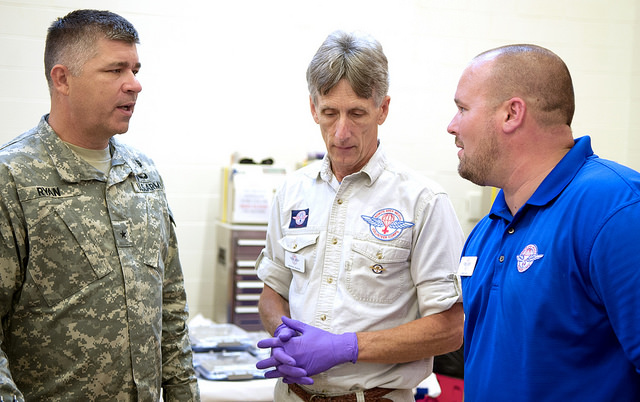
When Brig. Gen. Sean Ryan enters the room with other officers to assess the status of the exercise, he acknowledges Garreffa with a hearty handshake. She provides an update regarding logistics, patient numbers and the overall flow of the operation before returning to the dental treatment area.
3:00 p.m.
“Do you know what 5 pounds of fat looks like?” asks Yolanda Rios, a nutrition educator with Texas A&M AgriLife Extension in Edinburg, as she explains the visual aids spread out on a classroom desk at Palmview. A regular Operation Lone Star volunteer, she has met with families and individuals all day. Regardless of whether patients solicit her advice, Rios provides information about serving sizes, healthy snacks and the sugar content of popular foods and beverages.
“We try to help as much as we can,” Rios says. “We talk to patients with high blood pressure and high blood sugar. I suggest eating more fruits and vegetables and drinking less soda, and some of the kids are pretty good about that. Others tend to gain weight over the summer.”
Having medical screenings conducted in a nearby room means Rios can immediately counsel patients of all ages – some with diabetes and high blood pressure – about beneficial diet and lifestyle choices.
3:45 p.m.
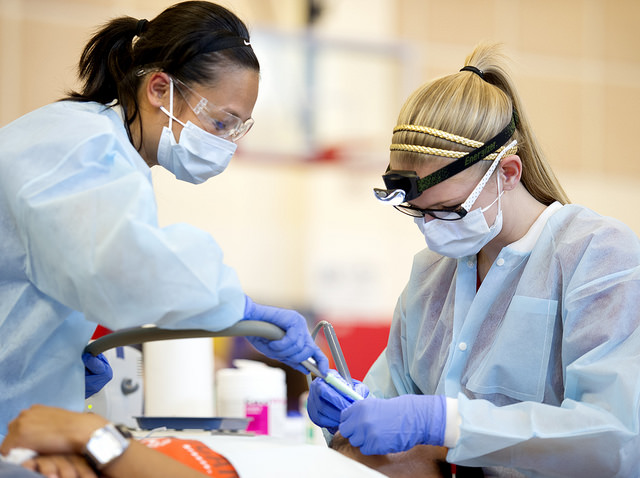
Cassidy Robinson, a second-year dental hygiene student, gathers sterile instruments in preparation for her fifth patient of the day.
She doesn’t know it yet, but this will be her most challenging case of the week. The woman, a diabetic, has been here since 4 a.m. and has not had food or medication since she arrived.
“At cleaning time, she was getting dizzy and not feeling well,” Robinson says. “I got her to take a sip of juice. She was initially refusing, we found out, because she thought she was going to lose her spot. I reassured her she could stay right in my chair and drink her juice. I had to clean her standing up because she couldn’t recline, and that was hard.”
The cases here are more dramatic than Robinson has seen at the dental school. She describes calculus buildup so severe it looked like several teeth were connected.
“I showed before and after pictures to a few people and asked them to run their tongue over their teeth and see how different they felt,” she says. “I know I didn’t do as good a job as I could have in the dental school due to the time crunch. There’s one patient I would have loved to have had in my chair at the school.”
Robinson recounts the first mission trip she took to Guatemala in February, an experience she describes as “amazing.”
“I honestly love doing volunteer work even though it’s constant all day. I like the back-to-back patients,” she says. “You know you’re not in a normal clinic setting. Chairs don’t move easily. We have head lamps stuck to our heads, and if you don’t have loupes you’re stuck with bad light. It’s the little things you don’t think much of, and then you get there and realize they make a big impact.”
4:00 p.m.
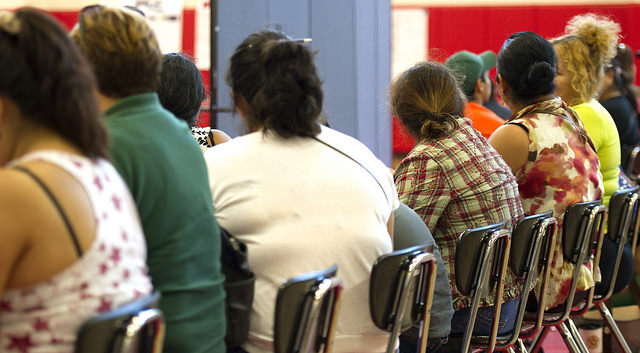
It is the official ending time for Operation Lone Star, but the gymnasium is far from empty. Most dental chairs are full, and more than a dozen people are still seated in the waiting area.
Ronnie Martin, RAM’s onsite equipment logistics manager, wonders aloud if someone should tell those folks they need to come back tomorrow. “We don’t want to tire out our volunteers on the first day,” he says.
Irene has just received a filling in a cracked tooth. She hasn’t eaten since she left home at 6 a.m. It is her first time at Operation Lone Star, and she did not think to bring snacks. Her sister is still waiting for her dental cleaning, hoping she will be seen before time runs out.
Irene has medical insurance but no vision or dental coverage. When she last needed a filling two years ago, she went to Mexico.
“I don’t want to go there again,” she says. “Lots of people go over there. I don’t think it’s that much cheaper. Here you have security if anything goes wrong.”
During the course of her day at Operation Lone Star, Irene has seen parents bring children for vaccines and school physicals. She has observed diabetics being sent to meet with the nutrition specialist. During wait times between service areas, she has helped late arrivals understand the process so they could receive help, too. The slip of paper in Irene’s hand is for claiming her new pair of bifocal glasses.
“Here they don’t know you by name,” she says. “They don’t ask for IDs. They’re here to do what needs to be done.
“Lots of people here don’t have another doctor. This is a big help for them; they really need it.”
6:00 p.m.
According to Chris Hall of RAM, TAMBCD students, faculty and other dental volunteers kept working until all of the day’s patients had been seen.
As the last of the Monday crowd trickled out, the waning South Texas sun greeted them. In a couple hours, the sidewalks and parking lot would fill again with the next day’s patients.
Editor’s Note: For patient privacy in this story, only first names are used. This story originally appeared in the Fall/Winter 2014 Baylor Dental Journal.